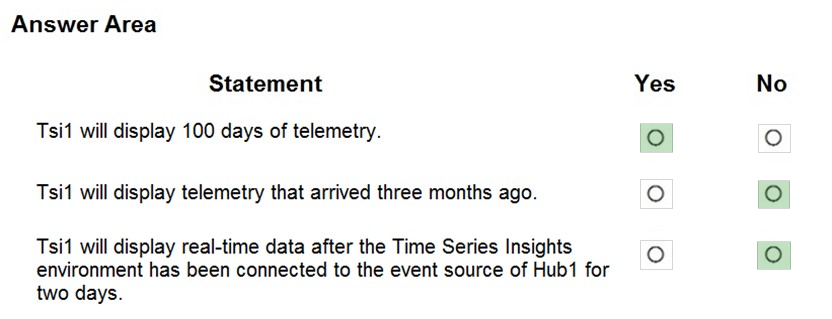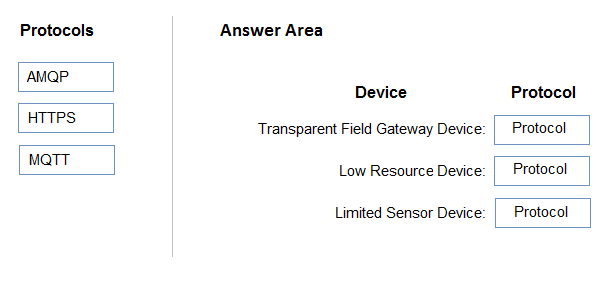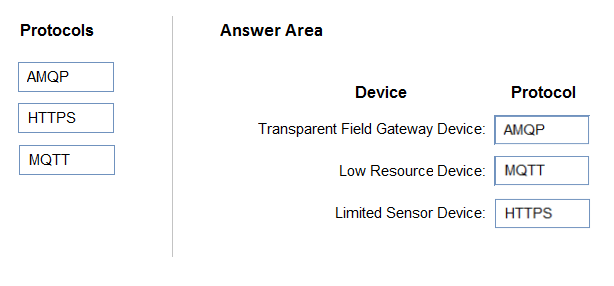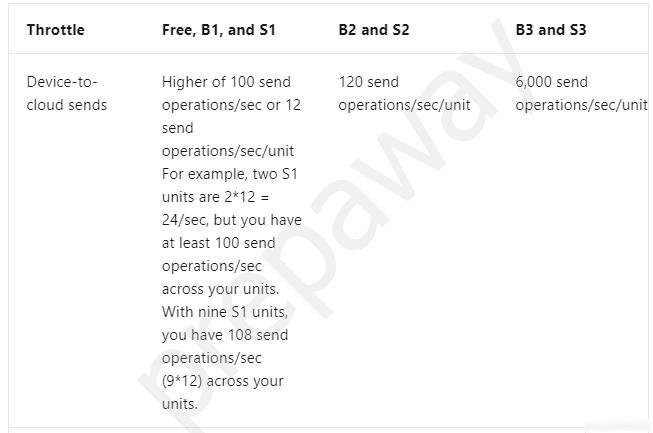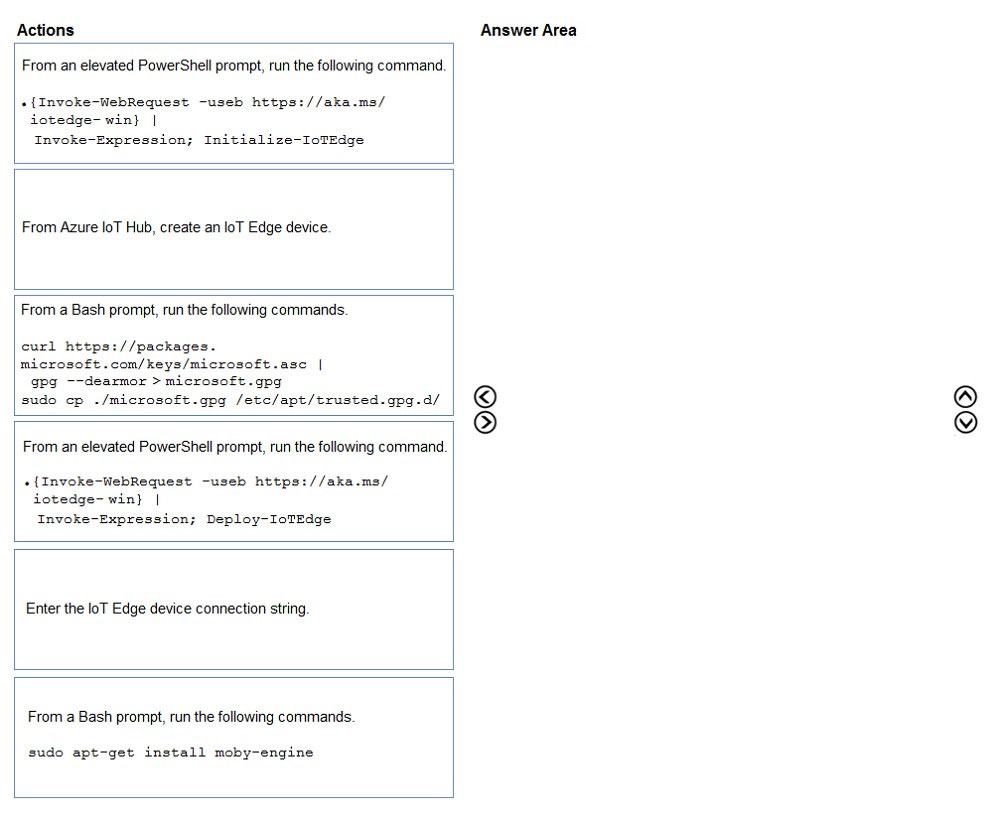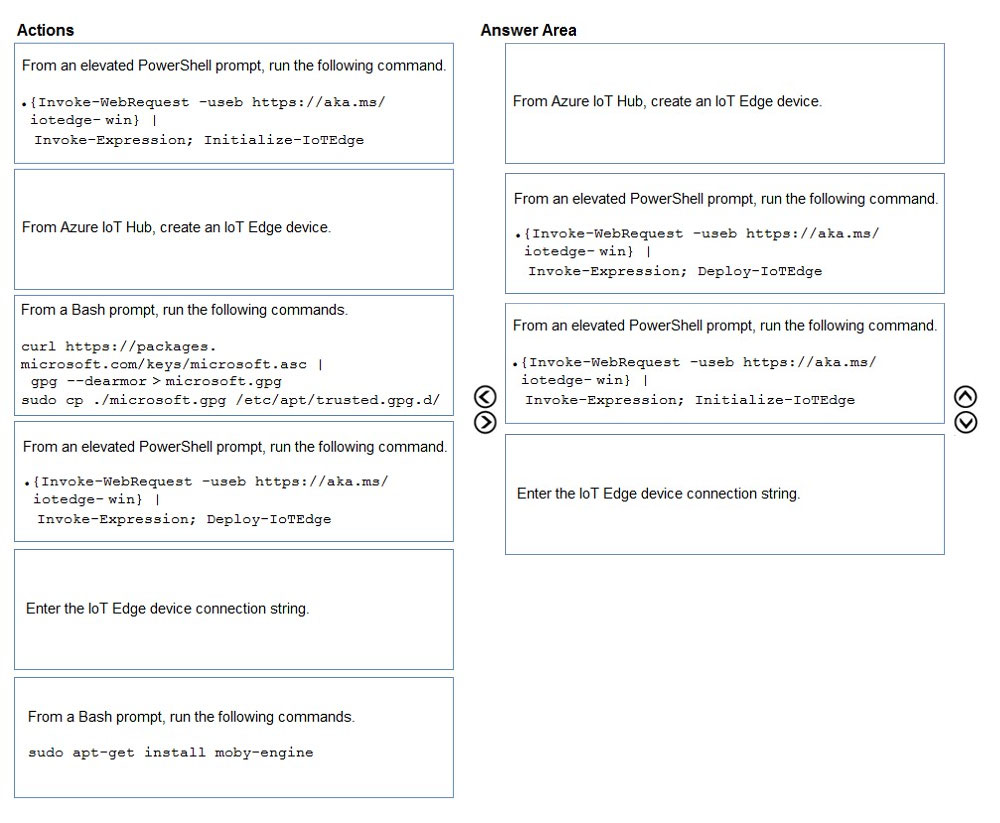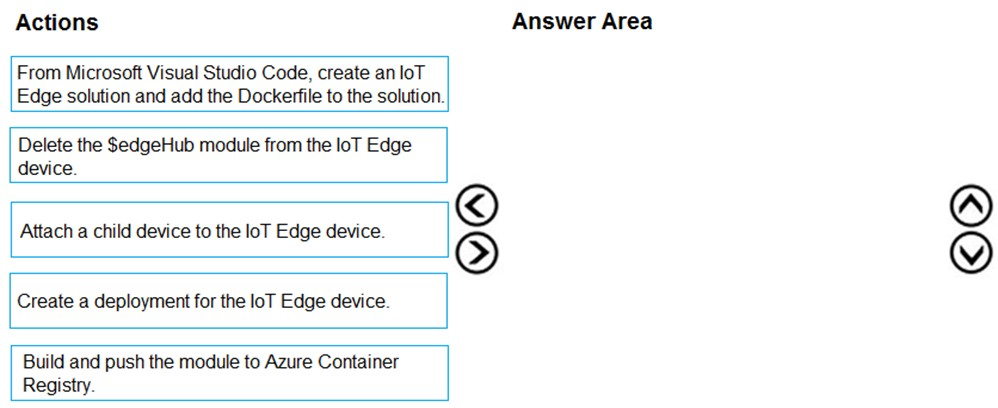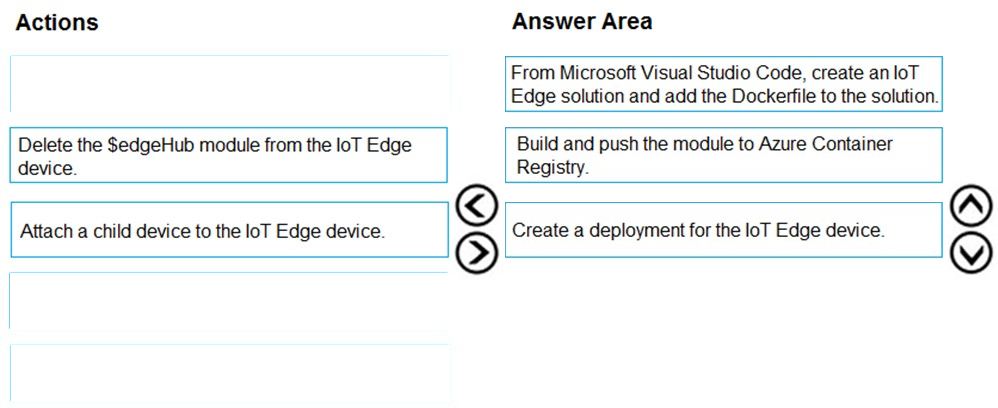AZ-220 Dump Free – 50 Practice Questions to Sharpen Your Exam Readiness.
Looking for a reliable way to prepare for your AZ-220 certification? Our AZ-220 Dump Free includes 50 exam-style practice questions designed to reflect real test scenarios—helping you study smarter and pass with confidence.
Using an AZ-220 dump free set of questions can give you an edge in your exam prep by helping you:
- Understand the format and types of questions you’ll face
- Pinpoint weak areas and focus your study efforts
- Boost your confidence with realistic question practice
Below, you will find 50 free questions from our AZ-220 Dump Free collection. These cover key topics and are structured to simulate the difficulty level of the real exam, making them a valuable tool for review or final prep.
After you answer a question in this section, you will NOT be able to return to it. As a result, these questions will not appear in the review screen. You have devices that connect to an Azure IoT hub. Each device has a fixed GPS location that includes latitude and longitude. You discover that a device entry in the identity registry of the IoT hub is missing the GPS location. You need to configure the GPS location for the device entry. The solution must prevent the changes from being propagated to the physical device. Solution: You add the desired properties to the device twin. Does the solution meet the goal?
A. Yes
B. No
You have an Azure subscription that contains an Azure IoT hub and two Azure IoT Edge devices named Device1 and Device2. You need to ensure that the IoT hub only accepts connections from Device1 and Device2. What should you configure?
A. Azure API Management
B. Identity Protection in Microsoft Azure Active Directory (Azure AD), part of Microsoft Entra
C. a Network Security Group
D. an IP filter
You have an Azure IoT solution that includes an Azure IoT hub and a Device Provisioning Service instance. Several enrolled devices are stolen. You need to prevent the stolen devices from connecting to the IoT solution. The solution must prevent the devices from re-enrollment and must be implemented as soon as possible. What should you do?
A. Delete the devices from the IoT hub.
B. Delete the device enrollments from the Device Provisioning Service.
C. Disable the devices in the IoT hub and delete from the IoT hub.
D. Disable the device enrollments in the Device Provisioning Service and delete the devices from the IoT hub.
You have an existing Azure IoT hub. You use IoT Hub jobs to schedule long running tasks on connected devices. Which two operations do the IoT Hub jobs support directly? Each correct answer presents a complete solution. NOTE: Each correct selection is worth one point.
A. Trigger Azure functions.
B. Invoke direct methods.
C. Update desired properties.
D. Send cloud-to-device messages.
E. Disable IoT device registry entries.
You have an Azure IoT Central application. You need to connect an IoT device to the application. Which two settings do you require in IoT Central to configure the device? Each correct answer presents part of the solution. NOTE: Each correct selection is worth one point.
A. Group SAS Primary Key
B. the IoT hub name
C. Scope ID
D. Application Name
E. Device ID
You have an Azure subscription named Sub1. You need to ensure that when a new Azure IoT hub is created in Sub1, a warning appears indicating that communication must be allowed only from known networks. The solution must minimize development and administrative effort. What should you include in the solution?
A. an application security group rule
B. an Azure function
C. an Azure policy
D. an Azure Monitor alert
After you answer a question in this section, you will NOT be able to return to it. As a result, these questions will not appear in the review screen. You have an Azure Stream Analytics job that receives input from an Azure IoT hub and sends the outputs to Azure Blob storage. The job has compatibility level 1.1 and six streaming units. You have the following query for the job.You plan to increase the streaming unit count to 12. You need to optimize the job to take advantage of the additional streaming units and increase the throughput. Solution: You change the query to the following.
Does this meet the goal?
A. Yes
B. No
You have an Azure IoT solution that contains an Azure IoT hub and Azure IoT Edge devices. You need to configure the metrics-collector module on the devices to send metrics to the IoT hub as device-to-cloud messages. Which environment variable should you update?
A. AllowedMetrics
B. LogAnalyticsWorkspaceId
C. UploadTarget
D. MetricsEndpointsCSVc
You have an Azure IoT hub that has a hostname of contoso-hub.azure-devices.net and an MCU-based IoT device named Device1. Device1 does NOT support Azure IoT SDKs. You plan to connect Device1 to the IoT hub by using the Message Queuing Telemetry Transport (MQTT) protocol and to authenticate by using X.509 certificates. You need to ensure that Device1 can authenticate to the IoT hub. What should you do?
A. Create an Azure key vault and enable the encryption of data at rest for the IoT hub by using a customer-managed key.
B. Enable a hardware security module (HSM) on Device1.
C. From the Azure portal, create an IoT Hub Device Provisioning Service (DPS) instance and add a certificate enrollment for Device1.
D. Add the DigiCert Baltimore Root Certificate to Device1.
You have an Azure IoT solution that contains an Azure IoT Edge device named Edge1. Edge1 fails to start. You connect to Edge1 and identify the following: • The IoT Edge agent is running. • The IoT Edge agent continually reports the following error: “Empty dconfig file.” • No modules have started. You need to ensure that Edge1 starts successfully. What should you do?
A. Update the /etc/hosts file for the host operating system and restart Edge1.
B. Reapply the iotedge config and restart Edge1.
C. Specify a DNS server for the container engine and restart Edge1.
D. Restart the Docker service.
You have an Azure IoT hub that uses a Device Provision Service instance. You plan to deploy 100 IoT devices. You need to confirm the identity of the devices by using the Device Provision Service. Which three device attestation mechanisms can you use? Each correct answer presents a complete solution. NOTE: Each correct selection is worth one point.
A. X.509 certificates
B. Trusted Platform Module (TPM) 2.0
C. Trusted Platform Module (TPM) 1.2
D. Symmetric key
E. Device Identity Composition Engine (DICE)
Which query should you use?
A. $event.payload.Status = “Running” AND $event.payload.Alert = “True”
B. $body.event.payload.Status = “Running” AND $body.event.payload.Alert = “True”
C. MessageType.payload.Status = “Running” AND MessageType.event.payload.Alert = “True”
D. $Status = “Running” AND $Alert = “True”
DRAG DROP - You have sites that contain IoT devices as shown in the following table.You have an Azure subscription. You need to create the Azure IoT Edge devices shown in the following table.
Which type of gateway pattern should you use for each IoT Edge device? To answer, drag the appropriate gateway pattern types to the correct devices. Each pattern type may be used once, more than once, or not at all. You may need to drag the split bar between panes or scroll to view content. NOTE: Each correct selection is worth one point.
After you answer a question in this section, you will NOT be able to return to it. As a result, these questions will not appear in the review screen. You have an Azure IoT solution that includes an Azure IoT hub and an Azure IoT Edge device. You plan to deploy 10 Bluetooth sensors. The sensors do not support MQTT, AMQP, or HTTPS. You need to ensure that all the sensors appear in the IoT hub as a single device. Solution: You configure the sensors to connect directly to the IoT hub. Does this meet the goal?
A. Yes
B. No
During the POV phase, you connect a device to IoT Hub and start sending telemetry messages. You need to verify the content of the messages received by IoT Hub during the POV phase. What should you use?
A. the Monitoring settings of IoT Hub or a Postman call to the IoT Hub REST API
B. Azure Monitor or Azure Log Analytics
C. Microsoft Visual Studio Code that uses the IoT Hub Toolkit or Azure CLI that uses the IoT Hub extension
D. Splunk or Grafana
You have an Azure Stream Analytics job that connects to an Azure IoT hub named Hub1445 as a streaming data source. Hub1445 is configured as shown in the exhibit.The Stream Analytics job fails to receive any messages from the IoT hub. What should you do to resolve the issue?
A. Disable the Route1 route.
B. Enable the Route3 route.
C. Disable the Route2 route.
D. Enable the fallback route.
HOTSPOT - You have an Azure IoT hub named Hub1 and an Azure Time Series Insights environment named tsi1. Tsi1 connects to Hub1. The solution has been operational for 6 months. Tsi1 is configured as shown in the following exhibit.Hub1 receives 1 million messages per day. Each message is up to 1 KB and is formatted as JSON. Hub1 has seven days of retained telemetry. For each of the following statements, select Yes if the statement is true. Otherwise, select No. NOTE: Each correct selection is worth one point. Hot Area:
DRAG DROP - You have an Azure IoT hub. You plan to attach three types of IoT devices as shown in the following table.You need to select the appropriate communication protocol for each device. What should you select? To answer, drag the appropriate protocols to the correct devices. Each protocol may be used once, more than once, or not at all. You may need to drag the split bar between panes or scroll to view content. NOTE: Each correct selection is worth one point. Select and Place:
You have 1,000 devices that connect to a standard tier Azure IoT hub. All the devices are commissioned and send telemetry events to the built-in IoT Hub endpoint. You configure message enrichment on the events endpoint and set the enrichment value to $twin.tags.ipV4. When you inspect messages on the events endpoint, you discover that all the messages are stamped with a string of "$twin.tags.ipV4". What are two possible causes of the issue? Each correct answer presents a complete solution. NOTE: Each correct selection is worth one point.
A. The ipV4 tag is a restricted twin property that is unavailable for message enrichment.
B. A standard tier IoT hub does not support device twin properties in message enrichments.
C. The device sending the message has no device twin.
D. Message enrichment cannot be added to messages going to a built-in endpoint.
E. The device twin path used for the value of the enrichment does not exist.
F. The device twin property value used for message enrichment is set to “$twin.tags.ipV4”.
DRAG DROP - You have the following Azure Stream Analytics query.You need to build a Stream Analytics query that will use a JavaScript user-defined aggregate (UDA) function named UDA1 to sum the TemperatureDB values. How should you complete the function? To answer, drag the appropriate values to the correct targets. Each value may be used once, more than once, or not at all. You may need to drag the split bar between panes or scroll to view content. NOTE: Each correct selection is worth one point.
You have an Azure IoT solution that includes multiple Azure IoT hubs in different geographic locations and a single Device Provision Service instance. You need to configure device enrollment to assign devices to the appropriate IoT hub based on the following requirements: ✑ The registration ID of the device The geographic location of the deviceThe load between the IoT hubs in the same geographic location must be balanced. What should you use to assign the devices to the IoT hubs?
A. Static configuration (via enrollment list only)
B. Lowest latency
C. Evenly weighted distribution
D. Custom (Use Azure Function)
You are configuring a production environment for an Azure IoT solution. You plan to deploy 1,000 IoT devices. Each device will send one device-to-cloud message every hour. Each message will be 4 KB. You need to deploy an Azure IoT hub that will support the IoT device deployment. The solution must meet the following requirements: ✑ Perform bulk device operations such as creating multiple device identities. ✑ Minimize costs What should you deploy?
A. one unit of the B1 tier
B. one unit of the free tier
C. one unit of the S1 tier
D. one unit of the S2 tier
You have an Azure subscription. You need to deploy an Azure IoT hub by using an Azure Resource Manager (ARM) template. The solution must ensure that the IoT hub rejects connections from devices that only support cipher suites that use SHA1. What should you include in the template?
A. “authenticationType”:“keyBased”
B. “disableDeviceSAS”:“true”
C. “disableModuleSAS”:“true”
D. “minTlsVersion”:“1.2”
You are troubleshooting an Azure IoT hub. You discover that some telemetry messages are dropped before they reach downstream processing. You suspect that IoT Hub throttling is the root cause. Which log in the Diagnostics settings of the IoT hub should you use to capture the throttling error events?
A. Routes
B. DeviceTelemetry
C. Connections
D. C2DCommands
DRAG DROP - You have an Azure IoT Central application that includes a Device Provisioning Service instance. You need to connect IoT devices to the application without first registering the devices. In which order should you perform the actions? To answer, move all actions from the list of actions to the answer area and arrange them in the correct order. Select and Place:
You need to visualize Azure IoT Hub telemetry data by using Microsoft Power BI. Which service should you connect to the IoT hub?
A. Azure Event Grid
B. SendGrid
C. Azure Stream Analytics
D. Azure Notification Hubs
HOTSPOT - You create an Azure IoT hub as shown in the following exhibit.For each of the following statements, select Yes if the statement is true. Otherwise, select No. NOTE: Each correct selection is worth one point.
You have an Azure IoT Central solution. You need to verify that telemetry messages from devices arrive to IoT Central. What should you use?
A. the Azure IoT explorer
B. the az command in Azure CLI
C. Azure Service Bus Explorer
D. the Azure IoT Tools for VS Code extension pack
You enable Azure Security Center for IoT. You need to onboard a device to Azure Security Center. What should you do?
A. Add the azureiotsecurity module identity to the Azure IoT Hub device identity.
B. Open incoming TCP port 8883 on the device.
C. Modify the connection string of the device.
D. Install an X.509 certificate on the hardware security module (HSM) of the device.
You have an Azure subscription that contains an Azure IoT hub, 500 IoT devices, and an Azure Time Series Insights Gen2 environment named Environment1. You need to add calculated values to the Time Series Model. What should you use?
A. instances
B. types
C. hierarchies
DRAG DROP - You have an Azure IoT solution that includes an Azure IoT hub, a Device Provisioning Service instance, and 1,000 connected IoT devices. The IoT devices are allocated to four enrollment groups. Each enrollment group is configured to use certificate attestation. You need to decommission all the devices in a single enrollment group and the enrollment group itself. Which three actions should you perform in sequence? To answer, move the appropriate actions from the list of actions to the answer area and arrange them in the correct order. Select and Place:
You have an Azure IoT hub that uses a Device Provisioning Service instance. You create a new individual device enrollment that uses symmetric key attestation. Which detail from the enrollment is required to auto provision the device by using the Device Provisioning Service?
A. the registration ID of the enrollment
B. the primary key of the enrollment
C. the device identity of the IoT hub
D. the hostname of the IoT hub
You have IoT devices that connect to an Azure IoT hub. From IoT Hub, you create an Event subscription to be notified when devices are registered to IoT Hub. You select webhook endpoint as a handler for the Event subscription. Which two types of Event Grid messages will be received by the webhook? Each correct answer presents a complete solution. NOTE: Each correct selection is worth one point.
A. Microsoft.Devices.DeviceCreated
B. Microsoft.Resources.ResourceWriteSuccess
C. Microsoft.EventGrid.SubscriptionValidationEvent
D. Microsoft.Devices.DeviceConnected
You have 1,000 IoT devices that connect to an Azure IoT hub. Each device has a property tag named city that is used to store the location of the device. You need to update the properties on all the devices located at an office in the city of Seattle as quickly as possible. Any new devices in the Seattle office that are added to the IoT hub must receive the updated properties also. What should you do?
A. From Automatic Device Management, create an IoT device configuration.
B. From the IoT hub, generate a query for the target devices.
C. Create a scheduled job by using the IoT Hub service SDKs.
D. Deploy an Azure IoT Edge transparent gateway to the Seattle office and deploy an Azure Stream Analytics edge job.
You need to configure Stream Analytics to meet the POV requirements. What are two ways to achieve the goal? Each correct answer presents a complete solution. NOTE: Each correct selection is worth one point.
A. From IoT Hub, create a custom event hub endpoint, and then configure the endpoint as an input to Stream Analytics.
B. Create a Stream Analytics module, and then deploy the module to all IoT Edge devices in the fleet.
C. Create an input in Stream Analytics that uses the built-in events endpoint of IoT Hub as the source.
D. Route telemetry to an Azure Blob storage custom endpoint, and then configure the Blob storage as a reference input for Stream Analytics.
DRAG DROP - You need to configure a digital twin to accept device telemetry data from the IoT hub. Which four actions should you perform in sequence? To answer, move the appropriate actions from the list of actions to the answer area and arrange them in the correct order.
DRAG DROP - You have an Azure subscription that contains an Azure IoT Edge device named Edge1 and an Azure container registry named Registry1. You need to configure Edge1 to connect to Registry1. How should you complete the deployment manifest? To answer, drag the appropriate values to the correct targets. Each value may be used once, more than once, or not at all. You may need to drag the split bar between panes or scroll to view content. NOTE: Each correct selection is worth one point.
HOTSPOT - You have an Azure IoT hub and three Azure IoT Edge devices. The device twin code for each device is shown in the following table.A standard automatic deployment is already applied. You have three layered deployments. The deployment code for each deployment is shown in the following table.
For each of the following statements, select Yes if the statement is true. Otherwise, select No. NOTE: Each correct selection is worth one point.
DRAG DROP - You are troubleshooting device connections to and disconnections from an Azure IoT hub. You configure diagnostic logging for the IoT hub to send to Log Analytics. You need to generate a report that displays the device connection and disconnection events. How should you complete the query? To answer, drag the appropriate values to the correct targets. Each value may be used once, more than once, or not at all. You may need to drag the split bar between panes or scroll to view content. NOTE: Each correct selection is worth one point. Select and Place:
You have an Azure IoT solution that includes an Azure IoT Hub named Hub1 and an Azure IoT Edge device named Edge1. Edge1 connects to Hub1. You need to deploy a temperature module to Edge1. What should you do?
A. From the Azure portal, navigate to Hub1 and select IoT Edge. Select Edge1, and then select Manage Child Devices. From a Bash prompt, run the following command: az iot edge set-modules –device-id Edge1 –hub-name Hub1 –content deploymentMan1.json
B. Create an IoT Edge deployment manifest that specifies the temperature module and the route to $upstream. From a Bash prompt, run the following command: az iot hub monitor-events –device-id Edge1 –hub-name Hub1
C. From the Azure portal, navigate to Hub1 and select IoT Edge. Select Edge1, select Device Twin, and then set the deployment manifest as a desired property. From a Bash prompt, run the following command: az iot hub monitor-events –device-id Edge1 –hub-name Hub1
D. Create an IoT Edge deployment manifest that specifies the temperature module and the route to $upstream. From a Bash prompt, run the following command: az iot edge set-modules –device-id Edge1 –hub-name Hub1 –content deploymentMan1.json
After you answer a question in this section, you will NOT be able to return to it. As a result, these questions will not appear in the review screen. You have an Azure Stream Analytics job that receives input from an Azure IoT hub and sends the outputs to Azure Blob storage. The job has compatibility level 1.1 and six streaming units. You have the following query for the job.You plan to increase the streaming unit count to 12. You need to optimize the job to take advantage of the additional streaming units and increase the throughput. Solution: You change the query to the following.
Does this meet the goal?
A. Yes
B. No
After you answer a question in this section, you will NOT be able to return to it. As a result, these questions will not appear in the review screen. You have an Azure IoT solution that includes an Azure IoT hub and an Azure IoT Edge device. You plan to deploy 10 Bluetooth sensors. The sensors do not support MQTT, AMQP, or HTTPS. You need to ensure that all the sensors appear in the IoT hub as a single device. Solution: You configure the IoT Edge device as an IoT Edge identity translation gateway. You configure the sensors to connect to the device. Does this meet the goal?
A. Yes
B. No
DRAG DROP - You need to install the Azure IoT Edge runtime on a new device that runs Windows 10 IoT Enterprise. Which four actions should you perform in sequence? To answer, move the appropriate actions from the list of actions to the answer area and arrange them in the correct order. Select and Place:
DRAG DROP - Your company develops a custom module and exports the module as a Linux Dockerfile. You need to deploy the module to an Azure IoT Edge device that runs Ubuntu Server 18.04. Which three actions should you perform in sequence? To answer, move the appropriate actions from the list of actions to the answer area and arrange them in the correct order. Select and Place:
You have three Azure IoT hubs named Hub1, Hub2, and Hub3, a Device Provisioning Service instance, and an IoT device named Device1. Each IoT hub is deployed to a separate Azure region. Device enrollment uses the Lowest latency allocation policy. The Device Provisioning Service uses the Lowest latency allocation policy. Device1 is auto-provisioned to Hub1 by using the Device Provisioning Service. Device1 regularly moves between regions. You need to ensure that Device1 always connects to the IoT hub that has the lowest latency. What should you do?
A. Configure device attestation that uses X.509 certificates.
B. Implement device certificate rolling.
C. Disenroll and reenroll Device1.
D. Configure the re-provisioning policy.
You have an Azure IoT solution that includes a basic tier Azure IoT hub named Hub1 and a Raspberry Pi device named Device1. Device1 connects to Hub1. You back up Device1 and restore the backup to a new Raspberry Pi device. When you start the new Raspberry Pi device, you receive the following error message in the diagnostic logs of Hub1: "409002 LinkCreationConflict." You need to ensure that Device1 and the new Raspberry Pi device can run simultaneously without error. Which two actions should you perform? Each correct answer presents part of the solution. NOTE: Each correct selection is worth one point.
A. On the new Raspberry Pi device, modify the connection string.
B. From Hub1, modify the device shared access policy.
C. Upgrade Hub1 to the standard tier.
D. From Hub1, create a new consumer group.
E. From Hub1, create a new IoT device.
DRAG DROP - You have an Azure IoT Edge solution. You plan to deploy an Azure Security Center for IoT security agent. You need to configure the security agent to meet the following requirements: ✑ Connection events must be reported as high priority. ✑ High priority events must be collected every seven minutes. How should you configure the azureiotsecurity module twin? To answer, drag the appropriate values to the correct locations. Each value may be used once, more than once, or not at all. You may need to drag the split bar between panes or scroll to view content. NOTE: Each correct selection is worth one point. Select and Place:
You need to update the IoT Edge runtime by using rolling tags. Which two actions should you perform? Each correct answer presents part of the solution. NOTE: Each correct selection is worth one point.
A. On the IoT Edge device, remove the edgeHub and edgeAgent container images.
B. Modify the systemModules section of the deployment manifest JSON file.
C. On the IoT Edge device, update the security daemon.
D. Add an update tag to the IoT Edge device twin.
You need to store the real-time alerts generated by Stream Analytics to meet the technical requirements. Which type of Stream Analytics output should you configure?
A. Azure Blob storage
B. Microsoft Power BI
C. Azure Cosmos DB
D. Azure SQL Database
You have an Azure IoT hub and an Azure virtual network. You configure a private endpoint for the IoT hub. You need to ensure that the IoT hub can send data to downstream services. What should you create first?
A. a consumer group
B. a managed identity
C. a message route
D. an IP filter rule
Access Full AZ-220 Dump Free
Looking for even more practice questions? Click here to access the complete AZ-220 Dump Free collection, offering hundreds of questions across all exam objectives.
We regularly update our content to ensure accuracy and relevance—so be sure to check back for new material.
Begin your certification journey today with our AZ-220 dump free questions — and get one step closer to exam success!






